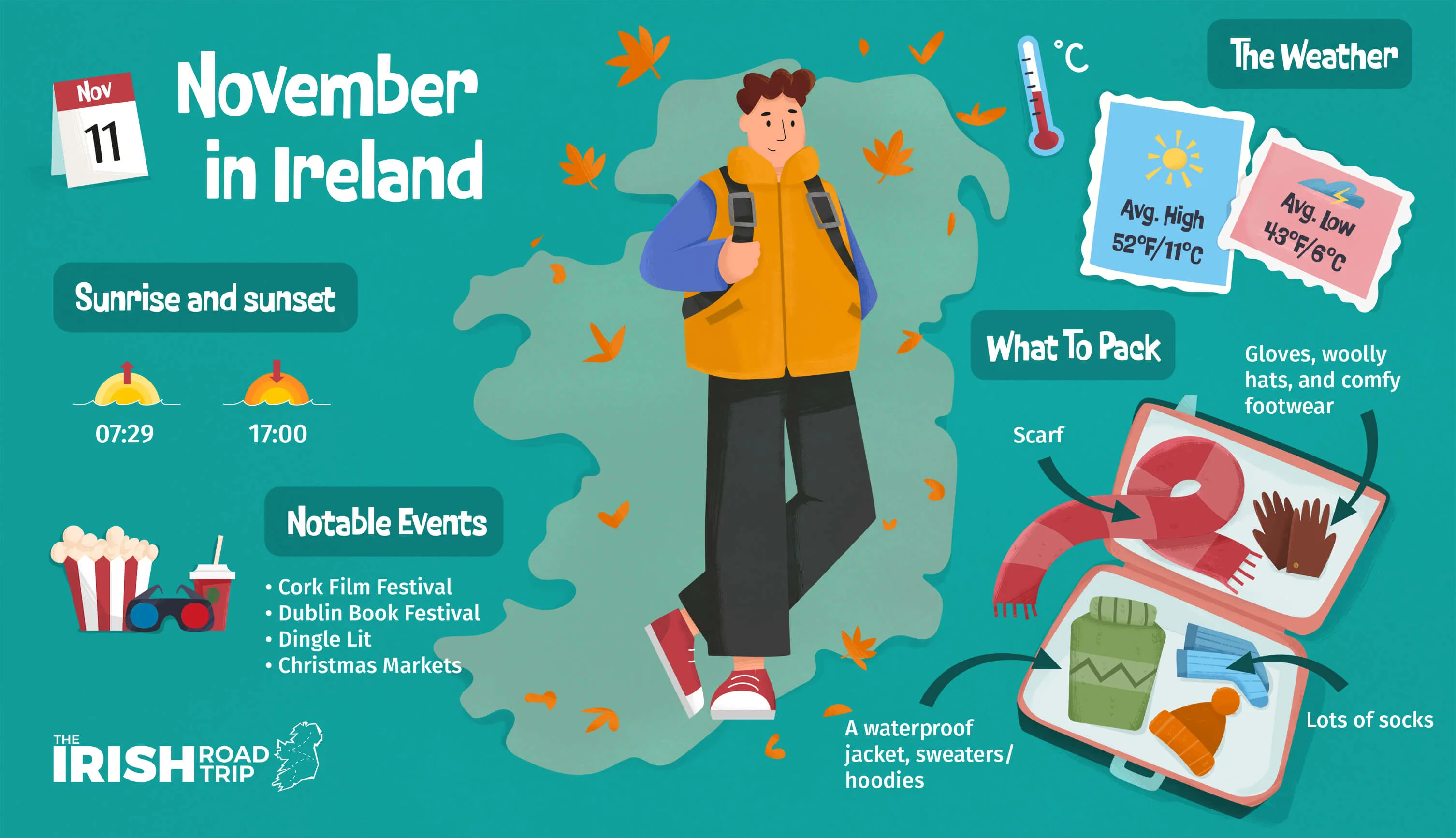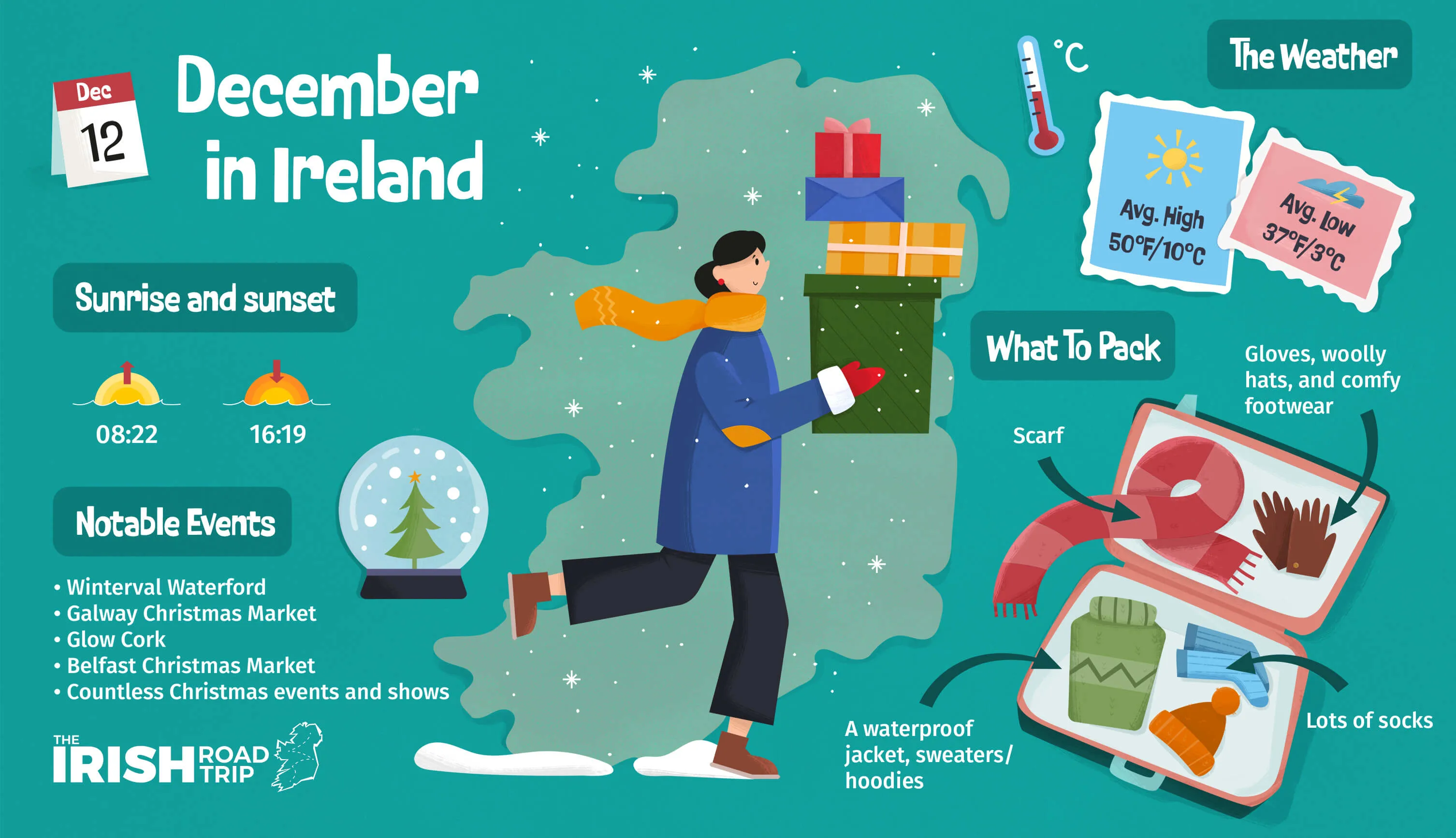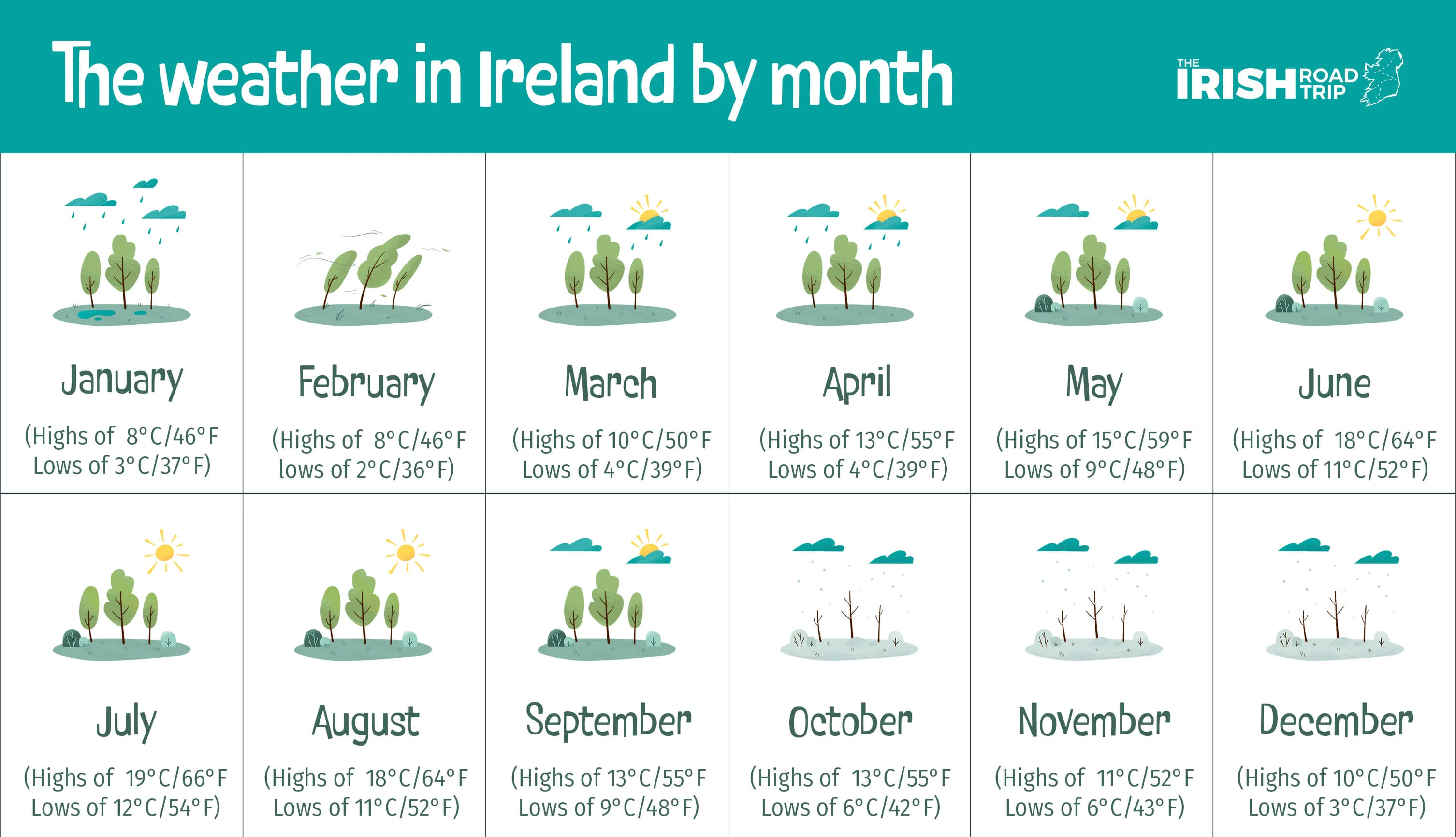There is no single best time of year to visit Ireland, and I’m saying that having lived here for 35 years.
‘Best’ is dependant on you. For example, if you want to visit when the weather in Ireland is likely to be good. ‘Best’ will be summer.
Below, you’ll find the pros and cons for each month to help you decide the best time to visit Ireland based on your likes and dislikes.
But first, a quick overview:
- Summer (Jun, Jul + Aug): Warmest months. Crowd/flight prices are at peak
- Winter (Dec, Jan + Feb): Coldest months. Crowd/flight prices are lower
- Autumn (Sept, Oct + Nov): Days long in Sept + Oct. Short + wintery in Nov
- Spring (Mar, Apr + May): Tends to be rainy in Mar + Apr. Summery in May
The best time to visit Ireland

If you take 20 seconds to look at the illustration above, you’ll get a quick insight into the months in Ireland and what to expect from each.
Below, you’ll find an overview of each month with info on average temperatures, festivals, what to wear in Ireland during that month along with travel tips for Ireland.
January
Ireland in January can be very hit and miss. The average temperature in January is 7°C/44.6°F with average lows of 3°C/37.4°F.
January is the best month to visit Ireland if you are working with a tight budget and you are willing to take a gamble with the weather.
Advantages
- Prices: If you’re visiting Ireland on a budget, flights and accommodation are cheaper
- Crowds: The popular attractions in Ireland will be quieter, as this is off-season
Disadvantages
- The weather: The days tend to be cold, wet, and windy
- Daylight: The sun rises from 08:29 and sets from 16:38
- Closed attractions: Some seasonal attractions will be closed
February
Visiting Ireland in February can also be risky weather wise, with average highs of 8°C/46.4°F and average lows of 2°C/35.6°F.
Spring is still far from the horizon and the days are short and chilly. In the past, we’ve had heavy snow fall, flooding and stormy weather in February.
February is the best time of year to go to Ireland if you have a limited budget and you aren’t too phased by potentially poor weather conditions.
Advantages
- Prices: February is off-season in Ireland, so flights and accommodation are cheaper
- Crowds: Ireland’s usually busy attractions will be quieter (the Guinness Storehouse and Giants Causeway will always draw crowds, though)
Disadvantages
- Weather: Similar to January – cold, wet and windy
- Daylight: The sun rises at 07:40 and sets at 17:37
- Seasonal attractions: Some seasonal attractions will remain closed
March
Many people want to visit Ireland in March to attend a St. Patrick’s Day festival or to soak up the buzz surrounding March 17th.
March marks the arrival of spring in Ireland. In years past, we’ve had heatwaves in March and stormy weather.
March is the best time to go to Ireland if you have a sizable budget and want to experience St. Patrick’s Day festivities. Spring has sprung, the days are longer and the weather isn’t as cold as the previous months.
Advantages
- Weather: March marks the start of spring. There are average highs of 10°C/50°F and average lows of 4°C/39.2°F
- Longish days: The sun rises at 07:12 and sets at 18:17
Disadvantages
- Prices: The period around March 17th sees prices skyrocket. The end of the month (Easter) can be pricey, also
- Weather: The weather can be very changeable. Over the last five years, we’ve had snow storms, heavy rainfall and scorching weather
- St. Patrick’s Day crowds: Crowds are at their peak (it’s for this reason that, for many, March won’t be the best time to visit Dublin)
April
in April, the weather has picked up, the days are longer and there are average highs of 13°C/55°F and average lows of 4°C/39.2°F.
The only issue with April, aside for the potential for bad weather, is that schools get two weeks off, which results in a shortage of accommodation in some places.
April is best time of year to visit Ireland if you’re working within a budget (after Easter) but want plenty of daylight hours to explore the island.
Advantages
- Flights: The cost of a trip to Ireland is much less in April, thanks to lower flight prices
- Long days: The sun rises at 06:23 and sets at 20:00
- Weather: The weather can to be nice and mild
Disadvantages
- Easter holidays: Schools get 2 weeks off around Easter, which can drive up the cost of accommodation
- Weather: The weather can also be terrible (see our April weather guide)
May
Along with September and October, May is the best time to visit Ireland. This is the shoulder season and the weather is mild, the days are long and both prices and tourist numbers are yet to skyrocket.
I.e. the weather is mild, the days are nice and long and we’ve haven’t yet reached the summer holidays, so places aren’t too busy (see our guide to Ireland in May for more).
Advantages
- Weather: The weather in May can be good, with mean temperatures ranging between 9.0°C/48.2°F and 13.0°C/55.4°F
- Long days: The sun rises at 05:17 and sets at 21:26
- Summer buzz: Long, mild days and the incoming summer tends to bring a lively atmosphere to many towns and villages
- Festivals: This is when they really start kicking off (see our Irish festivals calendar)
Disadvantages
- Weather: Yep – it’s a pro and a con – the weather in May can also be awful (it was last year!)
- Prices: Accommodation and flights will be near peak level price-wise
- Crowds: Better weather and long days means more people tourists
June
June in Ireland marks the arrival of summer, bringing with it warm and often dry weather and average highs of 18°C/64.4°F and lows of 11.6°C/52.88°F.
This is peak season in every sense – tourist numbers jump as do the price of flights and hotels.
June is regarded as the best time to travel to Ireland by many visiting tourists as the weather tends to be good, temperatures are mild and there’s plenty of daylight hours.
Advantages
- Weather: Weather tends to be dry and warm with highs of 18°C/64.4°F and lows of 11.6°C/52.88°F
- Long days: The sun rises at 05:03 and sets at 21:42
- Festivals: Numerous music festivals in Ireland take place during June
Disadvantages
- Prices: Demand is at its highest, so you can expect to spend more for flights and hotels
- Crowds: As June is peak season in Ireland, expect places to be more crowded
July
July is the best time to go to Ireland if you’re looking for good weather. Although it’s not guaranteed, it’s more likely to be fine in July than during many other months.
Personally, I head away for one week in Ireland every mid-July and, for the most part, we always get decent weather (see our guide to Ireland in July for more info).
Advantages
- Weather: We get average highs of 19°C/66.2°F and lows of 12°C/53.6°F
- Long days: The sun rises at 05:01 and sets at 21:56
- Summer buzz: Long, balmy days tend to bring tourists and a lively atmosphere to many towns, villages and cities
Disadvantages
- Prices: Summer is peak season, so you’ll be paying more for hotels, B&Bs and Airbnbs
- Crowds: As the schools are out for the summer, expect more crowds travelling around the island, especially to the likes of Killarney and the Dingle Peninsula
August
August boasts long days, warm weather and plenty to see and do (see our counties hub for endless places to visit).
As was the case with July, there’s several pros and cons for visiting Ireland in August, many of which revolve around the demand for accommodation and crowds.
August is the best time to go to Ireland if peak prices and crowds don’t bother you. The trade off is mild weather, long days and a busy festival calendar.
Advantages
- Weather: It’s usually good with highs of 18°C/64.4°F and lows of 11°C/51.8°F
- Long days: You’ll have 16 lovely hours of daylight to wander
- Summer buzz: Again, the summer months bring a buzzy atmosphere to many towns
Disadvantages
- Prices: Yep – prices are still at peak levels
- Crowds: The likes of the Dingle Peninsula, the Inishowen Peninsula, the Ring of Kerry and other tourist hot-spots will be very busy
September
Ireland in September is when the shift from a busy summer season takes place. Tourist numbers drop and the kids go back to school.
This is Ireland’s shoulder season (the season between peak season and the off season) and it’s a great time to explore.
September, along with May and October, is the best time to visit Ireland as prices drop, the days are long, the weather is mild and there’s less crowds.
Advantages
- Crowds: As kids have gone back to school, there’s less crowds
- The weather: The average high temperature tends to hover between 13°C/55.4°F and 16°C/60.8°F
- Flights: Flights should be a little cheaper as this is the shoulder season
- Long days: The days are starting to shorten, but the sun still rises early at 06:33 and sets at 20:15
Disadvantages
- Weather: Yep, a pro and a con. The weather, as always, is unpredictable. With that being said, we’ve had some great Septembers recently
October
October in Ireland is Autumn and you’ll find many places blanketed in orange leaves and the weather is cool and crisp.
Ireland experiences average highs of 13°C/55°F and average lows of 6°C/42°F during October
October, along with May and September, is the best time to go to Ireland thanks to lower flight and hotel prices, relatively long days and its often dry days with cool temperatures.
Advantages
- Weather: We often get Octobers that are sunny, crisp and dry
- Crowds: Ireland’s usually busy attractions will be less crowded as we’re no longer in peak-season
- Prices: Accommodation in the more off-the-beaten-track locations will be cheaper (you won’t notice a huge difference in the hot-spots)
- Prices: You should find that flights are cheaper than in peak-season
Disadvantages
- Shorter days: By mid-October, the sun won’t rise until 08:00 and it sets at 18:40
- Weather: The weather in Ireland in October is unpredictable (see our October weather guide)
- Mid-term: Schools break in Ireland at Halloween for a week and hotel prices jump
November
Visiting Ireland in November comes with its pros and cons. On the plus side, many towns and villages come alive with Christmas markets from mid-month.
On the con side, it’s winter, so the weather can be all over the place. November tends to be cool and crisp with an average temperature in Ireland in November between 12°C/53.6°F and 9.5°C/49.1°F.
November is the best time to travel to Ireland for a city break. Many cities (Galway, Dublin, Cork and Belfast) holding Christmas markets.
Advantages
- Crowds: You’ll encounter fewer crowds at the usually busy attractions (although places with Christmas markets will be busy)
- Prices: Accommodation in the more off-the-beaten-track towns in Ireland will be more affordable
- Flights: Should be cheaper as we’ll be in the depths of the off-season
Disadvantages
- Short days: The sun doesn’t rise until 07:23 and it sets early at 16:53
- Seasonal attractions: Some seasonal attractions in Ireland’s quieter villages in towns will be closed
- Weather: The weather could be wintery. We’ve had mild, stormy and freezing cold Novembers in the past few years
December
December marks the arrival of Christmas in Ireland and you’ll find most towns and villages alight with fairy lights.
The average temperature for Ireland in December tends to be similar to November, coming in at around 5°C/41°F, but this can vary.
December is the best time to visit Ireland if you’re happy to chance the weather and you want to experience Christmas markets, cosy pubs with big open fires and less crowds.
Advantages
- Festive buzz: Most towns and villages in Ireland will be decked out in Christmas lights
- Crowds: You’ll encounter fewer crowds at the usually busy attractions
- Prices: Accommodation in the more off-the-beaten-track towns and villages will be cheaper
Disadvantages
- Flights: Flights can be pricey with people flying home for Christmas
- Short days: Sun rises at 08:16 and sets around 16:10
- Weather: The weather in December has been mild for several years, but there’s also a good chance of rain and strong winds
The best time to go to Ireland climate wise
For most, the best months to visit Ireland will be the ones where the weather is at its best. For those planning a trip to Ireland on a budget, it’ll likely be the off-season months.
Below, I’ll give you an overview of the climate in Ireland by month in some of the tourist hot-spots, like Killarney. This data comes from Met Eireann, the Irish Meteorological Service.
Need help with your Ireland itinerary? We recently published the world’s largest library of Irish Road Trip guides (and it’s free!)
Summer (June, July and August)
| Destination | Jun | Jul | Aug |
|---|---|---|---|
| Killarney | 13.5 °C/56.3 °F | 14.9 °C/58.7 °F | 14.5 °C/58.2 °F |
| Dublin | 13.5 °C/56.4 °F | 15.2 °C/59.3 °F | 14.8 °C/58.6 °F |
| Cobh | 15.4 °C/59.7 °F | 15.6 °C/60.1 °F | 15.4 °C/59.7 °F |
| Galway | 14 °C/57.2 °F | 15.3 °C/59.5 °F | 15 °C/58.9 °F |
Autumn (September, October and November)
| Destination | Sept | Oct | Nov |
|---|---|---|---|
| Killarney | 13.2 °C/55.7 °F | 10.6 °C/51 °F | 7.5 °C/45.6 °F |
| Dublin | 13.1 °C/ 55.5 °F | 10.3 °C/ 50.5 °F | 7 °C/ 44.6 °F |
| Cobh | 14 °C/ 57.3 °F | 11.6 °C/52.8 °F | 8.6 °C/47.4 °F |
| Galway | 13.6 °C/56.4 °F | 10.8 °C/51.5 °F | 7.9 °C/46.2 °F |
Winter (December, January and February)
| Destination | Dec | Jan | Feb |
|---|---|---|---|
| Killarney | 6 °C/42.9 °F | 5.5 °C/42 °F | 5.5 °C/42 °F |
| Dublin | 4.8 °C/40.6 °F | 4.7 °C/40.5 °F | 4.8 °C/40.6 °F |
| Cobh | 7.1 °C/44.8 °F | 6.5 °C/43.8 °F | 6.4 °C/43.5 °F |
| Galway | 5.9 °C/42.5 °F | 5.8 °C/42.5 °F | 5.9 °C/42.5 °F |
Spring (March, April and May)
| Destination | Mar | Apr | May |
|---|---|---|---|
| Killarney | 5.5 °C/42 °F | 8.4 °C/47.1 °F | 11 °C/51.9 ° |
| Dublin | 3 °C/37.4 °F | 4.8 °C/40.6 °F | 7.6 °C/45.6 °F |
| Cobh | 7.1 °C/44.8 °F | 8.8 °C/47.9 °F | 11.4 °C/52.5 °F |
| Galway | 6.9 °C/44.4 °F | 8.9 °C/48 °F | 11.6 °C/52.9 °F |
Keith O’Hara has lived in Ireland for 35 years and has spent most of the last 10 creating what is now The Irish Road Trip guide. Over the years, the website has published thousands of meticulously researched Ireland travel guides, welcoming 30 million+ visitors along the way. In 2022, the Irish Road Trip team published the world’s largest collection of Irish Road Trip itineraries. Keith lives in Dublin with his dog Toby and finds writing in the 3rd person minus craic altogether.















Janine
Monday 8th of March 2021
Hi! Thank you so much for all of your wonderful tips! My husband and I are planning to bring our adult daughters (24 and 29) to visit at the end is September. We are very excited! Should we stay in Dublin and then take our guided tours from there? We will have 9-10 days. Thank you! Janine
Amy
Thursday 27th of February 2020
We just booked a trip to southern Ireland for November. I am very excited. Can you recommend some must do's while we are there?
Keith
Wednesday 4th of March 2020
Hi Amy,
If you hop into our guide to the counties of Ireland you'll find heaps of things to do!
Cheers,
Keith
Toni
Thursday 30th of January 2020
Hi Keith Thankyou for the great read. My daughter and I are wanting to travel to Ireland for Xmas from Australia. As it will be cold n rainy which doesn’t really bother us, but worried we mighten get to see a lot of attractions would many be closed? Cheers Toni ?
Keith
Saturday 1st of February 2020
Hi Toni,
If you pop in the name of the attraction into Google and visit the official site you should get an idea of whether or not they'll be open or close when you're visiting.
Everywhere will be closed on Christmas Day with many places also staying closed on December 26th, but that can change from attraction to attraction.
Cheers,
Keith